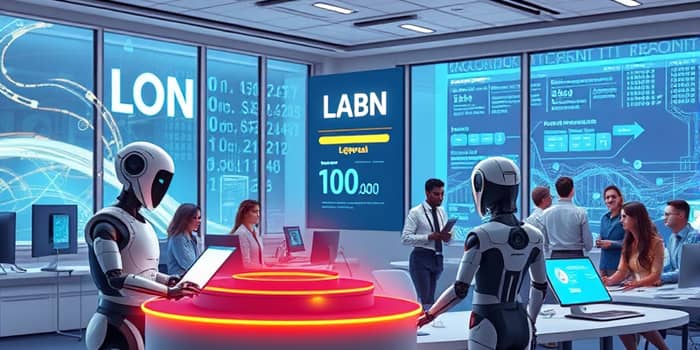In an era defined by rapid technological progress, the personal lending landscape is undergoing a profound transformation. Traditional, paper-heavy processes are giving way to digital systems that promise speed, efficiency, and greater accessibility for borrowers and lenders alike. This article explores how automated lending is reshaping financial services and offers practical insights for industry professionals and consumers aiming to navigate this brave new world.
Understanding Automated Lending
Automated lending refers to the use of sophisticated technology to manage the entire loan lifecycle—from application intake to approval and repayment. By leveraging advanced software, these platforms can streamline all stages of the loan cycle, reducing human intervention and operating costs. Automated systems perform credit checks, risk assessments, and compliance reviews in a fraction of the time required by manual underwriting.
This shift is driven by a confluence of technologies designed to extract and analyze data at unprecedented speed and accuracy. Institutions that embrace automation can unlock new markets, tailor products to individual needs, and scale operations without proportionally increasing headcount or overhead.
Key Technologies Driving Loan Automation
The backbone of automated lending platforms consists of several interlocking technologies. Each plays a vital role in ensuring applications are processed swiftly, accurately, and securely.
- Artificial Intelligence (AI) – Learns from historical data to make predictive decisions and detect fraud.
- Machine Learning (ML) – Continuously refines risk models based on new information.
- Robotic Process Automation (RPA) – Automates repetitive tasks such as data entry and document sorting.
- Optical Character Recognition (OCR) – Converts paper or scanned documents into machine-readable text.
- Intelligent Image Analysis – Verifies identity documents and extracts critical information securely.
Beyond Traditional Underwriting
Manual underwriting often involves days of back-and-forth communication, manual data entry, and human review. In comparison, automated systems can underwrite thousands of applications in minutes. They dramatically minimize costly manual data entry while reducing the risk of human error and bias.
Below is a high-level comparison demonstrating the transformative potential of automation:
Benefits for Lenders
Lenders who deploy automated loan origination systems can achieve remarkable gains in efficiency, risk management, and customer satisfaction. With technology handling routine tasks, staff can focus on strategic priorities, such as product innovation and relationship building.
- Increased operational efficiency and application throughput – Handle larger volumes without hiring.
- Advanced risk analytics powered by AI for more accurate credit decisions.
- Streamlined workflows reduce bottlenecks and accelerate closing rates.
- Lower cost per loan through reduced manual labor and infrastructure needs.
Benefits for Borrowers
For consumers, the advantages of automated lending are equally compelling. Gone are the days of waiting anxiously for a credit decision: modern platforms can deliver rapid approvals and reduced funding times, empowering individuals to seize opportunities when they arise.
Borrowers also enjoy:
personalized borrower experiences and tailored offers based on their unique financial profiles. Digital interfaces guide applicants through each step, offering real-time feedback and recommendations for optimal loan products. Further, those with limited credit histories can benefit from algorithms that assess alternative data points, opening doors for “thin-file” consumers who might otherwise be overlooked.
Challenges and Considerations
While automation offers myriad advantages, it is not without its challenges. Financial institutions must balance technological innovation with regulatory compliance and human oversight.
- Human intervention remains essential for complex or edge-case applications.
- Ensuring fairness and transparency in AI-driven decisions to prevent unintended bias.
- Maintaining robust cybersecurity measures to protect sensitive customer data.
Successful lenders adopt a hybrid approach, combining the speed of automation with the judgment of experienced loan officers. This model ensures that unusual cases receive appropriate attention while routine applications proceed unhindered.
Looking Ahead: The Road to Full Automation
The trajectory of personal lending points toward even deeper integration of intelligent technologies. Future platforms may feature conversational interfaces that ask follow-up questions, collect additional documentation, and provide instant feedback without any human touchpoints. Advances in natural language processing will allow systems to interpret unstructured data, such as emails or chat transcripts, for more holistic risk assessments.
Moreover, lenders will increasingly harness alternative data—ranging from utility payments to social network behavior—to refine credit scores and expand inclusion. As AI models become more sophisticated, it will be possible to achieve error-free decision-making at scale, further boosting confidence in automated underwriting.
Conclusion
Automated loans represent a seismic shift in how credit is extended and managed. By embracing these technologies, lenders can unlock new efficiencies, mitigate risk more effectively, and design more personalized products. Borrowers stand to benefit from faster approvals, transparent processes, and greater access to capital.
The future of personal lending is not a distant horizon—it is unfolding today. Institutions that invest wisely in automation will lead the market, while consumers who understand these tools will be better positioned to achieve their financial goals. This convergence of innovation and customer-centricity heralds an exciting new chapter in the democratization of credit.
References
- https://www.investopedia.com/terms/a/automated_underwriting.asp
- https://www.itmagination.com/blog/automated-credit-loan-processing-guide
- https://newgensoft.com/blog/need-automated-loan-processing-system/
- https://www.moodys.com/web/en/us/insights/lending/maximize-efficiency-how-automation-can-improve-your-loan-origination-process.html
- https://www.scnsoft.com/lending/loan-automation
- https://www.inscribe.ai/loan-underwriting
- https://www.getdefacto.com/article/automated-underwriting
- https://www.consumercomplianceoutlook.org/2017/second-issue/keeping-fintech-fair-thinking-about-fair-lending-and-udap-risks










